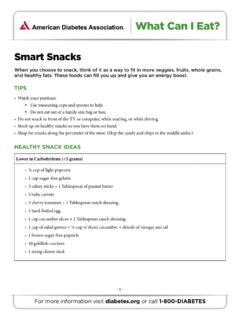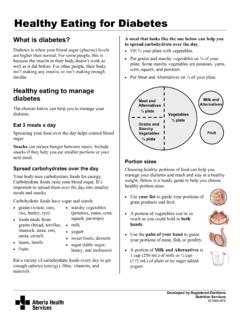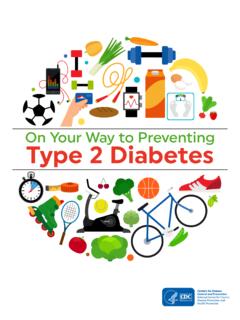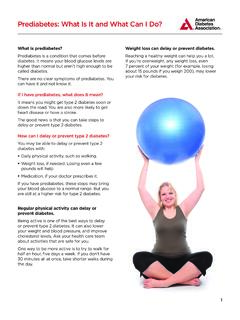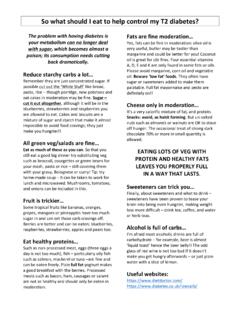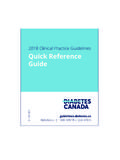Transcription of Diet and type 2 diabetes - dgft.nhs.uk
1 Introduction This booklet gives some general information about what to eat and drink if you have type 2 diabetes . If you need more detailed advice, please ask your GP to refer you to a registered dietitian. What is type 2 diabetes ? Type 2 diabetes occurs when the level of glucose (sugar) in the blood is too high. In people without type 2 diabetes , a hormone called insulin helps to control blood glucose levels. Insulin acts like a key and allows glucose to move from the blood into the cells that make up your body. Your cells use glucose as fuel.
2 In people with type 2 diabetes , the main problem is that the insulin produced cannot work properly, which is known as insulin resistance. As time living with type 2 diabetes increases, the amount of insulin produced by the pancreas may also reduce. If diabetes has not yet been diagnosed or it is poorly controlled, high blood glucose levels may cause the following symptoms: Tiredness. Excessive thirst. Weight loss. Passing water more often. Diet and type 2 diabetes Nutrition and Dietetics Patient Information Leaflet Page 2 How is diabetes managed?
3 It is managed in one of four ways, depending on the person and the type of diabetes : 1. Diet alone. 2. Diet and tablets (for example, metformin and gliclazide). 3. Diet and insulin. 4. Diet, tablets and insulin. Can type 2 diabetes be put into remission? Recent evidence has shown that for many overweight or obese adults with type 2 diabetes , losing 15kg (2 stone 5lbs) as soon as possible after diagnosis is successful for achieving remission. Remission means that your blood glucose levels are below the diabetic range, usually without you needing to take any diabetes medication.
4 If you feel this amount of weight loss is not realistic, but you would like to improve your blood glucose levels and reduce the risk of cardiovascular disease (CVD), it is recommended to lose at least five per cent of body weight if you are overweight or obese ( body mass index, also known as BMI, more than or equal to 25 kg/m2). Any dietary approach that results in weight loss could be suitable, including low-fat, low-carb, high-protein and Mediterranean. The most important factor is choosing the dietary approach that you can stick to long-term.
5 How can I keep my blood glucose levels in target? The main food group that affects blood glucose levels is carbohydrates. Reducing carbohydrate consumption is one way to improve blood glucose control and lose weight. Carbohydrates Starchy Foods Foods containing sugar Simple sugars Natural sugars Bread/cobs/rolls Rice Crackers Potatoes (chips and crisps) Pasta Breakfast cereals Anything made with flour Chapatti/naan/roti Couscous Pastry (pies, sausage rolls) Yam Fufu Plantain Eba/gari Coating breaded/batter Sugar Jam Fizzy drinks Sweets Cakes Biscuits Desserts Chocolate Jar sauces Sauces (ketchup/brown/BBQ) Tinned spaghetti Fruit juice Honey Maple syrup Milk Yoghurt All fruit Page 3 Simple sugars Minimise these foods first (above in bold)
6 To help control blood glucose. Replace sugar/honey in drinks and on food with artificial sweeteners. Choose diet drinks or sugar-free versions. Natural sugars Limit fruit to two to three small portions per day spread out. One portion is 80g, a fun-size banana, a medium apple, one quarter of a mango, a handful of grapes/berries. Milk and yogurt are a good source of calcium when eaten in moderation and should contribute to your recommended two to three portions of calcium per day (see advice on Calcium on page 4 of this leaflet). It is advised you opt for no added sugar or plain natural/Greek yogurt.
7 Starchy carbohydrates (yellow on the meal plate below) Portion size is very important. Only have one portion at each meal and avoid double portions, pasta and garlic bread, burger bun and chips. For weight loss, aim to fill one quarter of your plate with starchy carbohydrates. Suggested portion sizes: o Two medium slices of bread. o Four tablespoons of cooked rice/pasta/couscous. o Four egg-sized new potatoes. o One medium wrap/chapatti/pitta. o Half of a fist-sized portion of fufu/plantain. o Two slices of boiled yam. Choose high-fibre low glycaemic index (GI) carbohydrates, seeded or wholegrain bread, brown/long-grain/basmati rice, ideally wholegrain pasta or white pasta cooked firm, and porridge (made from jumbo oats).
8 To the one quarter plate of carbohydrates, add a one quarter plate of protein (chicken, meat, fish, eggs, vegetarian alternatives, cheese, and beans) and a half plate of vegetables/salad. Fibre It is recommended that we consume 30g of fibre per day. Fibre is found in wholegrain, starchy carbohydrates, fruit, vegetables, and legumes (beans, peas, lentils). Fibre helps to keep our bowels regular and healthy. Page 4 If you are increasing your fibre intake, it is important to do so slowly to avoid unpleasant side-effects and to also increase fluid consumption.
9 It is advised to choose a wide variety of different vegetables of different colours to get different nutrients and support a healthy digestive system. What are the other aspects of a healthy diet with diabetes ? Healthy fats Healthy fats are essential for life. These include oily fish, extra virgin olive oil, avocado, nuts and seeds. It is recommended that adults with diabetes consume two portions of oily fish per week, salmon, mackerel, sardines and pilchards. Calcium Calcium is important for healthy bones and teeth. Aim for two to three portions of calcium per day.
10 One portion is: o 200ml milk o 150g Greek/plain/no added sugar yogurt o 30g (matchbox-size) cheese Non-dairy sources include: o Plant-based milks, soya/almond/coconut (with added calcium) o Spinach, broccoli, cabbage, okra and spring greens o Tofu o Almonds o Sardines and pilchards o Beans and dahl Iron Iron is important to avoid tiredness and anaemia. Some good sources include: o Red meat, beef, lamb, pork o White meat and fish o Beans, peas, lentils o Nuts and seeds o Eggs o Spinach, cabbage, broccoli o Tofu Protein Protein foods are the most filling.





